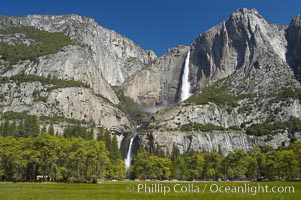
Yosemite Falls rises above Cooks Meadow. The 2425 falls, the tallest in North America, is at peak flow during a warm-weather springtime melt of Sierra snowpack. Yosemite Valley.
Location: Yosemite Falls, Yosemite National Park, California
Image ID: 16141
Location: Yosemite Falls, Yosemite National Park, California
Image ID: 16141
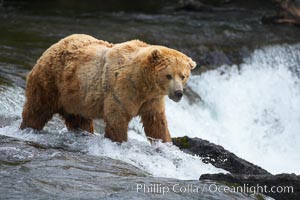
A large, old brown bear (grizzly bear) wades across Brooks River. Coastal and near-coastal brown bears in Alaska can live to 25 years of age, weigh up to 1400 lbs and stand over 9 feet tall.
Species: Brown bear, Ursus arctos
Location: Brooks River, Katmai National Park, Alaska
Image ID: 17038
Species: Brown bear, Ursus arctos
Location: Brooks River, Katmai National Park, Alaska
Image ID: 17038
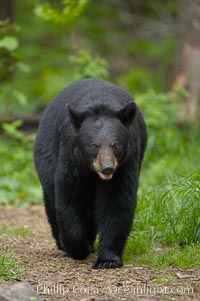
Black bear walking in a forest. Black bears can live 25 years or more, and range in color from deepest black to chocolate and cinnamon brown. Adult males typically weigh up to 600 pounds. Adult females weight up to 400 pounds and reach sexual maturity at 3 or 4 years of age. Adults stand about 3' tall at the shoulder.
Species: American black bear, Ursus americanus
Location: Orr, Minnesota
Image ID: 18751
Species: American black bear, Ursus americanus
Location: Orr, Minnesota
Image ID: 18751
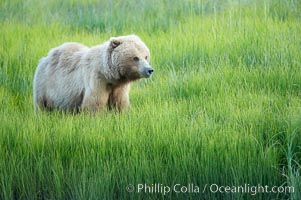
Coastal brown bear in meadow. The tall sedge grasses in this coastal meadow are a food source for brown bears, who may eat 30 lbs of it each day during summer while waiting for their preferred food, salmon, to arrive in the nearby rivers.
Species: Brown bear, Ursus arctos
Location: Lake Clark National Park, Alaska
Image ID: 19166
Species: Brown bear, Ursus arctos
Location: Lake Clark National Park, Alaska
Image ID: 19166
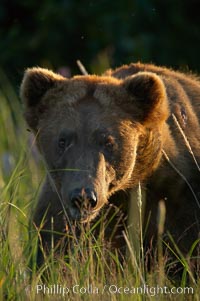
Mature male brown bear boat walks in tall sedge grass.
Species: Brown bear, Ursus arctos
Location: Lake Clark National Park, Alaska
Image ID: 19172
Species: Brown bear, Ursus arctos
Location: Lake Clark National Park, Alaska
Image ID: 19172
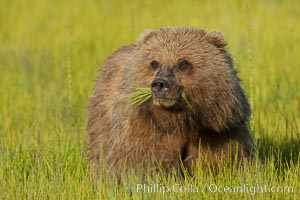
Young brown bear grazes in tall sedge grass. Brown bears can consume 30 lbs of sedge grass daily, waiting weeks until spawning salmon fill the rivers.
Species: Brown bear, Ursus arctos
Location: Lake Clark National Park, Alaska
Image ID: 19173
Species: Brown bear, Ursus arctos
Location: Lake Clark National Park, Alaska
Image ID: 19173
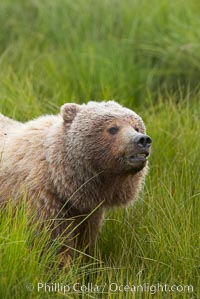
Coastal brown bear in meadow. The tall sedge grasses in this coastal meadow are a food source for brown bears, who may eat 30 lbs of it each day during summer while waiting for their preferred food, salmon, to arrive in the nearby rivers.
Species: Brown bear, Ursus arctos
Location: Lake Clark National Park, Alaska
Image ID: 19183
Species: Brown bear, Ursus arctos
Location: Lake Clark National Park, Alaska
Image ID: 19183
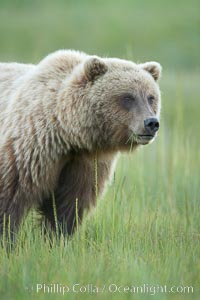
Coastal brown bear in meadow. The tall sedge grasses in this coastal meadow are a food source for brown bears, who may eat 30 lbs of it each day during summer while waiting for their preferred food, salmon, to arrive in the nearby rivers.
Species: Brown bear, Ursus arctos
Location: Lake Clark National Park, Alaska
Image ID: 19187
Species: Brown bear, Ursus arctos
Location: Lake Clark National Park, Alaska
Image ID: 19187
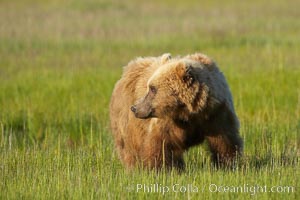
Coastal brown bear in meadow. The tall sedge grasses in this coastal meadow are a food source for brown bears, who may eat 30 lbs of it each day during summer while waiting for their preferred food, salmon, to arrive in the nearby rivers.
Species: Brown bear, Ursus arctos
Location: Lake Clark National Park, Alaska
Image ID: 19193
Species: Brown bear, Ursus arctos
Location: Lake Clark National Park, Alaska
Image ID: 19193
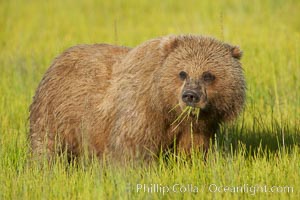
Young brown bear grazes in tall sedge grass. Brown bears can consume 30 lbs of sedge grass daily, waiting weeks until spawning salmon fill the rivers.
Species: Brown bear, Ursus arctos
Location: Lake Clark National Park, Alaska
Image ID: 19196
Species: Brown bear, Ursus arctos
Location: Lake Clark National Park, Alaska
Image ID: 19196
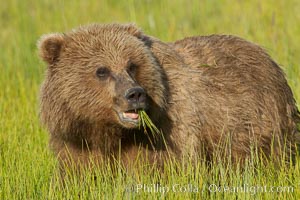
Young brown bear grazes in tall sedge grass. Brown bears can consume 30 lbs of sedge grass daily, waiting weeks until spawning salmon fill the rivers.
Species: Brown bear, Ursus arctos
Location: Lake Clark National Park, Alaska
Image ID: 19197
Species: Brown bear, Ursus arctos
Location: Lake Clark National Park, Alaska
Image ID: 19197
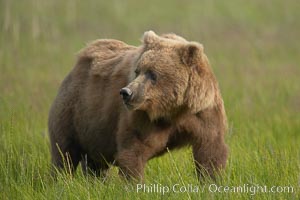
Coastal brown bear in meadow. The tall sedge grasses in this coastal meadow are a food source for brown bears, who may eat 30 lbs of it each day during summer while waiting for their preferred food, salmon, to arrive in the nearby rivers.
Species: Brown bear, Ursus arctos
Location: Lake Clark National Park, Alaska
Image ID: 19200
Species: Brown bear, Ursus arctos
Location: Lake Clark National Park, Alaska
Image ID: 19200
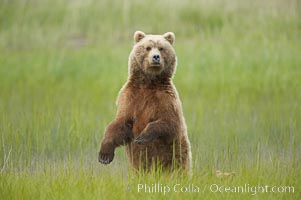
A brown bear mother (sow) stands in tall sedge grass to look for other approaching bears that may be a threat to her cubs.
Species: Brown bear, Ursus arctos
Location: Lake Clark National Park, Alaska
Image ID: 19204
Species: Brown bear, Ursus arctos
Location: Lake Clark National Park, Alaska
Image ID: 19204
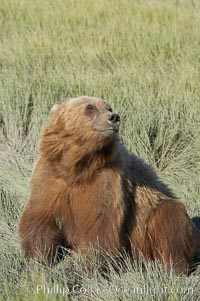
Coastal brown bear in meadow. The tall sedge grasses in this coastal meadow are a food source for brown bears, who may eat 30 lbs of it each day during summer while waiting for their preferred food, salmon, to arrive in the nearby rivers.
Species: Brown bear, Ursus arctos
Location: Lake Clark National Park, Alaska
Image ID: 19218
Species: Brown bear, Ursus arctos
Location: Lake Clark National Park, Alaska
Image ID: 19218
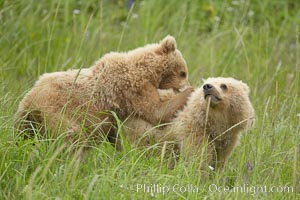
Coastal brown bear cubs playing in tall sedge grass.
Species: Brown bear, Ursus arctos
Location: Lake Clark National Park, Alaska
Image ID: 19227
Species: Brown bear, Ursus arctos
Location: Lake Clark National Park, Alaska
Image ID: 19227
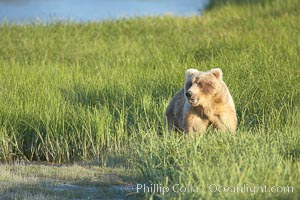
Coastal brown bear in meadow. The tall sedge grasses in this coastal meadow are a food source for brown bears, who may eat 30 lbs of it each day during summer while waiting for their preferred food, salmon, to arrive in the nearby rivers.
Species: Brown bear, Ursus arctos
Location: Lake Clark National Park, Alaska
Image ID: 19235
Species: Brown bear, Ursus arctos
Location: Lake Clark National Park, Alaska
Image ID: 19235
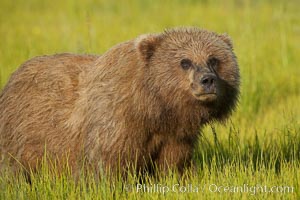
Portrait of a young brown bear, pausing while grazing in tall sedge grass. Brown bears can consume 30 lbs of sedge grass daily, waiting weeks until spawning salmon fill the rivers.
Species: Brown bear, Ursus arctos
Location: Lake Clark National Park, Alaska
Image ID: 19245
Species: Brown bear, Ursus arctos
Location: Lake Clark National Park, Alaska
Image ID: 19245
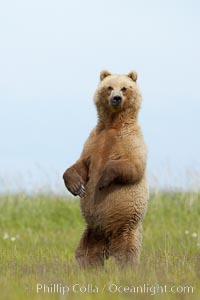
A brown bear mother (sow) stands in tall sedge grass to look for other approaching bears that may be a threat to her cubs.
Species: Brown bear, Ursus arctos
Location: Lake Clark National Park, Alaska
Image ID: 19249
Species: Brown bear, Ursus arctos
Location: Lake Clark National Park, Alaska
Image ID: 19249
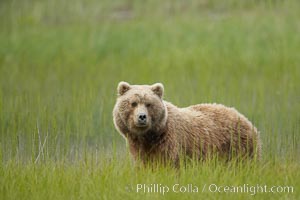
Coastal brown bear in meadow. The tall sedge grasses in this coastal meadow are a food source for brown bears, who may eat 30 lbs of it each day during summer while waiting for their preferred food, salmon, to arrive in the nearby rivers.
Species: Brown bear, Ursus arctos
Location: Lake Clark National Park, Alaska
Image ID: 19253
Species: Brown bear, Ursus arctos
Location: Lake Clark National Park, Alaska
Image ID: 19253
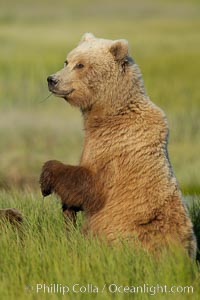
A brown bear mother (sow) stands in tall sedge grass to look for other approaching bears that may be a threat to her cubs.
Species: Brown bear, Ursus arctos
Location: Lake Clark National Park, Alaska
Image ID: 19258
Species: Brown bear, Ursus arctos
Location: Lake Clark National Park, Alaska
Image ID: 19258
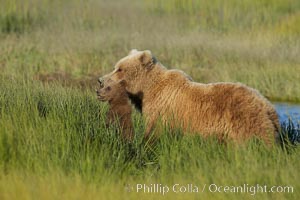
Female mother brown bear sow and spring cub in tall sedge grass.
Species: Brown bear, Ursus arctos
Location: Lake Clark National Park, Alaska
Image ID: 19259
Species: Brown bear, Ursus arctos
Location: Lake Clark National Park, Alaska
Image ID: 19259
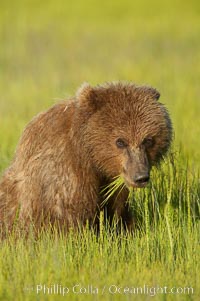
Young brown bear grazes in tall sedge grass. Brown bears can consume 30 lbs of sedge grass daily, waiting weeks until spawning salmon fill the rivers.
Species: Brown bear, Ursus arctos
Location: Lake Clark National Park, Alaska
Image ID: 19263
Species: Brown bear, Ursus arctos
Location: Lake Clark National Park, Alaska
Image ID: 19263
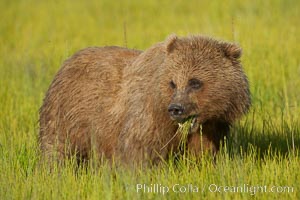
Young brown bear grazes in tall sedge grass. Brown bears can consume 30 lbs of sedge grass daily, waiting weeks until spawning salmon fill the rivers.
Species: Brown bear, Ursus arctos
Location: Lake Clark National Park, Alaska
Image ID: 19264
Species: Brown bear, Ursus arctos
Location: Lake Clark National Park, Alaska
Image ID: 19264
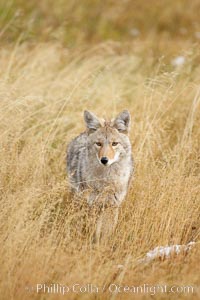
A coyote hunts for voles in tall grass, autumn.
Species: Coyote, Canis latrans
Location: Yellowstone National Park, Wyoming
Image ID: 19651
Species: Coyote, Canis latrans
Location: Yellowstone National Park, Wyoming
Image ID: 19651
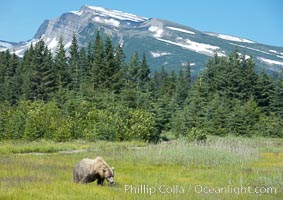
Coastal brown bear in meadow. The tall sedge grasses in this coastal meadow are a food source for brown bears, who may eat 30 lbs of it each day during summer while waiting for their preferred food, salmon, to arrive in the nearby rivers.
Species: Brown bear, Ursus arctos
Location: Lake Clark National Park, Alaska
Image ID: 19188
Species: Brown bear, Ursus arctos
Location: Lake Clark National Park, Alaska
Image ID: 19188
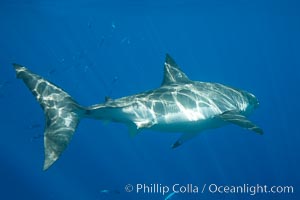
A great white shark swims away, showing its powerful caudal fin (tail), short anal fins on its underside, tall dorsal fin on top and sweeping winglike pectoral fins.
Species: Great white shark, Carcharodon carcharias
Location: Guadalupe Island (Isla Guadalupe), Baja California, Mexico
Image ID: 19466
Species: Great white shark, Carcharodon carcharias
Location: Guadalupe Island (Isla Guadalupe), Baja California, Mexico
Image ID: 19466
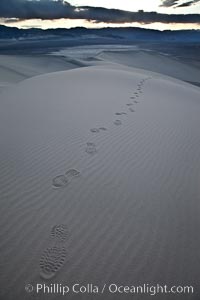
Footprints in the sand, Eureka Dunes. The Eureka Valley Sand Dunes are California's tallest sand dunes, and one of the tallest in the United States. Rising 680' above the floor of the Eureka Valley, the Eureka sand dunes are home to several endangered species, as well as "singing sand" that makes strange sounds when it shifts. Located in the remote northern portion of Death Valley National Park, the Eureka Dunes see very few visitors.
Location: Eureka Dunes, Death Valley National Park, California
Image ID: 25271
Location: Eureka Dunes, Death Valley National Park, California
Image ID: 25271
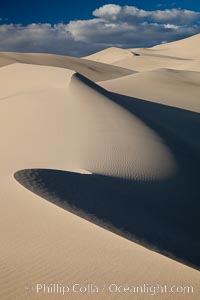
Eureka Dunes. The Eureka Valley Sand Dunes are California's tallest sand dunes, and one of the tallest in the United States. Rising 680' above the floor of the Eureka Valley, the Eureka sand dunes are home to several endangered species, as well as "singing sand" that makes strange sounds when it shifts. Located in the remote northern portion of Death Valley National Park, the Eureka Dunes see very few visitors.
Location: Eureka Dunes, Death Valley National Park, California
Image ID: 25272
Location: Eureka Dunes, Death Valley National Park, California
Image ID: 25272
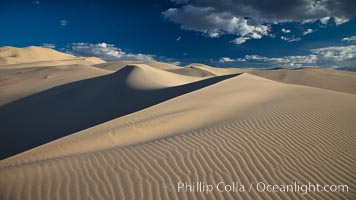
Eureka Dunes. The Eureka Valley Sand Dunes are California's tallest sand dunes, and one of the tallest in the United States. Rising 680' above the floor of the Eureka Valley, the Eureka sand dunes are home to several endangered species, as well as "singing sand" that makes strange sounds when it shifts. Located in the remote northern portion of Death Valley National Park, the Eureka Dunes see very few visitors.
Location: Eureka Dunes, Death Valley National Park, California
Image ID: 25273
Location: Eureka Dunes, Death Valley National Park, California
Image ID: 25273
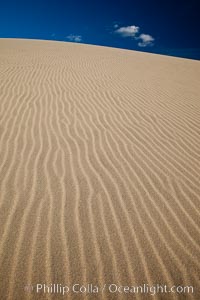
Eureka Dunes. The Eureka Valley Sand Dunes are California's tallest sand dunes, and one of the tallest in the United States. Rising 680' above the floor of the Eureka Valley, the Eureka sand dunes are home to several endangered species, as well as "singing sand" that makes strange sounds when it shifts. Located in the remote northern portion of Death Valley National Park, the Eureka Dunes see very few visitors.
Location: Eureka Dunes, Death Valley National Park, California
Image ID: 25275
Location: Eureka Dunes, Death Valley National Park, California
Image ID: 25275